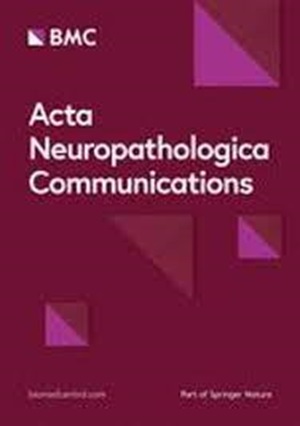正常情况下和急性轴突变性期间体内大鼠视神经轴突自噬囊泡的运输
IF 6.2
2区 医学
Q1 NEUROSCIENCES
引用次数: 0
摘要
神经元由于其细长的过程,对自噬等降解过程构成了特别的挑战。自噬小泡(AV)在轴突顶端形成,并被运输回体细胞。这种运输是必不可少的,因为囊泡内容物的最终降解只发生在靠近轴突或轴突内的地方。在这里,我们利用病毒载体介导的 LC3 标记和双光子显微镜在大鼠视神经中建立了一个体内活体成像模型,以分析 AV 的轴突运输。在活体基础条件下,50% 的动眼神经在运动,其中 85% 的动眼神经逆行运输。逆行方向的运输速度高于顺行方向。视神经的挤压损伤会导致轴突逆行运输迅速中断,而顺行运输则在数小时内保持完好。在挤压后的最初 6 小时内,靠近病变部位的 AVs 形成速度加快,但邻近轴突中 AVs 的清除速度和溶酶体标记物的水平降低。挤压病变后,动力蛋白的适配蛋白p150Glued的表达明显减少。在体外,轴突切断术后溶酶体标志物 cathepsin D 与 AVs 的融合和共定位减少。综上所述,我们在此首次利用活体成像技术对哺乳动物中枢神经系统的轴突AV运输进行了体内分析。我们发现,轴突切断术会导致逆行性运动的严重缺陷以及通过溶酶体系统清除 AVs 的减少。本文章由计算机程序翻译,如有差异,请以英文原文为准。
Axonal autophagic vesicle transport in the rat optic nerve in vivo under normal conditions and during acute axonal degeneration
Neurons pose a particular challenge to degradative processes like autophagy due to their long and thin processes. Autophagic vesicles (AVs) are formed at the tip of the axon and transported back to the soma. This transport is essential since the final degradation of the vesicular content occurs only close to or in the soma. Here, we established an in vivo live-imaging model in the rat optic nerve using viral vector mediated LC3-labeling and two-photon-microscopy to analyze axonal transport of AVs. Under basal conditions in vivo, 50% of the AVs are moving with a majority of 85% being transported in the retrograde direction. Transport velocity is higher in the retrograde than in the anterograde direction. A crush lesion of the optic nerve results in a rapid breakdown of retrograde axonal transport while the anterograde transport stays intact over several hours. Close to the lesion site, the formation of AVs is upregulated within the first 6 h after crush, but the clearance of AVs and the levels of lysosomal markers in the adjacent axon are reduced. Expression of p150Glued, an adaptor protein of dynein, is significantly reduced after crush lesion. In vitro, fusion and colocalization of the lysosomal marker cathepsin D with AVs are reduced after axotomy. Taken together, we present here the first in vivo analysis of axonal AV transport in the mammalian CNS using live-imaging. We find that axotomy leads to severe defects of retrograde motility and a decreased clearance of AVs via the lysosomal system.
求助全文
通过发布文献求助,成功后即可免费获取论文全文。
去求助
来源期刊

Acta Neuropathologica Communications
Medicine-Pathology and Forensic Medicine
CiteScore
11.20
自引率
2.80%
发文量
162
审稿时长
8 weeks
期刊介绍:
"Acta Neuropathologica Communications (ANC)" is a peer-reviewed journal that specializes in the rapid publication of research articles focused on the mechanisms underlying neurological diseases. The journal emphasizes the use of molecular, cellular, and morphological techniques applied to experimental or human tissues to investigate the pathogenesis of neurological disorders.
ANC is committed to a fast-track publication process, aiming to publish accepted manuscripts within two months of submission. This expedited timeline is designed to ensure that the latest findings in neuroscience and pathology are disseminated quickly to the scientific community, fostering rapid advancements in the field of neurology and neuroscience. The journal's focus on cutting-edge research and its swift publication schedule make it a valuable resource for researchers, clinicians, and other professionals interested in the study and treatment of neurological conditions.
 求助内容:
求助内容: 应助结果提醒方式:
应助结果提醒方式:


